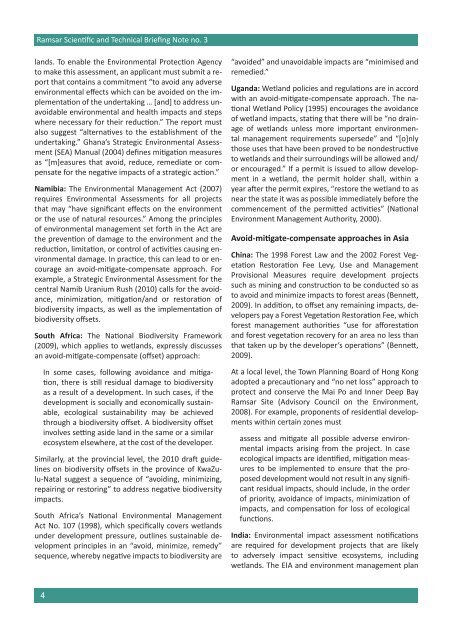Briefing Note - Ramsar Convention on Wetlands
Briefing Note - Ramsar Convention on Wetlands
Briefing Note - Ramsar Convention on Wetlands
You also want an ePaper? Increase the reach of your titles
YUMPU automatically turns print PDFs into web optimized ePapers that Google loves.
<str<strong>on</strong>g>Ramsar</str<strong>on</strong>g> Scientific and Technical <str<strong>on</strong>g>Briefing</str<strong>on</strong>g> <str<strong>on</strong>g>Note</str<strong>on</strong>g> no. 3<br />
lands. To enable the Envir<strong>on</strong>mental Protecti<strong>on</strong> Agency<br />
to make this assessment, an applicant must submit a report<br />
that c<strong>on</strong>tains a commitment “to avoid any adverse<br />
envir<strong>on</strong>mental effects which can be avoided <strong>on</strong> the implementati<strong>on</strong><br />
of the undertaking … [and] to address unavoidable<br />
envir<strong>on</strong>mental and health impacts and steps<br />
where necessary for their reducti<strong>on</strong>.” The report must<br />
also suggest “alternatives to the establishment of the<br />
undertaking.” Ghana’s Strategic Envir<strong>on</strong>mental Assessment<br />
(SEA) Manual (2004) defines mitigati<strong>on</strong> measures<br />
as “[m]easures that avoid, reduce, remediate or compensate<br />
for the negative impacts of a strategic acti<strong>on</strong>.”<br />
Namibia: The Envir<strong>on</strong>mental Management Act (2007)<br />
requires Envir<strong>on</strong>mental Assessments for all projects<br />
that may “have significant effects <strong>on</strong> the envir<strong>on</strong>ment<br />
or the use of natural resources.” Am<strong>on</strong>g the principles<br />
of envir<strong>on</strong>mental management set forth in the Act are<br />
the preventi<strong>on</strong> of damage to the envir<strong>on</strong>ment and the<br />
reducti<strong>on</strong>, limitati<strong>on</strong>, or c<strong>on</strong>trol of activities causing envir<strong>on</strong>mental<br />
damage. In practice, this can lead to or encourage<br />
an avoid-mitigate-compensate approach. For<br />
example, a Strategic Envir<strong>on</strong>mental Assessment for the<br />
central Namib Uranium Rush (2010) calls for the avoidance,<br />
minimizati<strong>on</strong>, mitigati<strong>on</strong>/and or restorati<strong>on</strong> of<br />
biodiversity impacts, as well as the implementati<strong>on</strong> of<br />
biodiversity offsets.<br />
South Africa: The Nati<strong>on</strong>al Biodiversity Framework<br />
(2009), which applies to wetlands, expressly discusses<br />
an avoid-mitigate-compensate (offset) approach:<br />
In some cases, following avoidance and mitigati<strong>on</strong>,<br />
there is still residual damage to biodiversity<br />
as a result of a development. In such cases, if the<br />
development is socially and ec<strong>on</strong>omically sustainable,<br />
ecological sustainability may be achieved<br />
through a biodiversity offset. A biodiversity offset<br />
involves setting aside land in the same or a similar<br />
ecosystem elsewhere, at the cost of the developer.<br />
Similarly, at the provincial level, the 2010 draft guidelines<br />
<strong>on</strong> biodiversity offsets in the province of KwaZulu-Natal<br />
suggest a sequence of “avoiding, minimizing,<br />
repairing or restoring” to address negative biodiversity<br />
impacts.<br />
South Africa’s Nati<strong>on</strong>al Envir<strong>on</strong>mental Management<br />
Act No. 107 (1998), which specifically covers wetlands<br />
under development pressure, outlines sustainable development<br />
principles in an “avoid, minimize, remedy”<br />
sequence, whereby negative impacts to biodiversity are<br />
“avoided” and unavoidable impacts are “minimised and<br />
remedied.”<br />
Uganda: Wetland policies and regulati<strong>on</strong>s are in accord<br />
with an avoid-mitigate-compensate approach. The nati<strong>on</strong>al<br />
Wetland Policy (1995) encourages the avoidance<br />
of wetland impacts, stating that there will be “no drainage<br />
of wetlands unless more important envir<strong>on</strong>mental<br />
management requirements supersede” and “[o]nly<br />
those uses that have been proved to be n<strong>on</strong>destructive<br />
to wetlands and their surroundings will be allowed and/<br />
or encouraged.” If a permit is issued to allow development<br />
in a wetland, the permit holder shall, within a<br />
year after the permit expires, “restore the wetland to as<br />
near the state it was as possible immediately before the<br />
commencement of the permitted activities” (Nati<strong>on</strong>al<br />
Envir<strong>on</strong>ment Management Authority, 2000).<br />
Avoid-mitigate-compensate approaches in Asia<br />
China: The 1998 Forest Law and the 2002 Forest Vegetati<strong>on</strong><br />
Restorati<strong>on</strong> Fee Levy, Use and Management<br />
Provisi<strong>on</strong>al Measures require development projects<br />
such as mining and c<strong>on</strong>structi<strong>on</strong> to be c<strong>on</strong>ducted so as<br />
to avoid and minimize impacts to forest areas (Bennett,<br />
2009). In additi<strong>on</strong>, to offset any remaining impacts, developers<br />
pay a Forest Vegetati<strong>on</strong> Restorati<strong>on</strong> Fee, which<br />
forest management authorities “use for afforestati<strong>on</strong><br />
and forest vegetati<strong>on</strong> recovery for an area no less than<br />
that taken up by the developer’s operati<strong>on</strong>s” (Bennett,<br />
2009).<br />
At a local level, the Town Planning Board of H<strong>on</strong>g K<strong>on</strong>g<br />
adopted a precauti<strong>on</strong>ary and “no net loss” approach to<br />
protect and c<strong>on</strong>serve the Mai Po and Inner Deep Bay<br />
<str<strong>on</strong>g>Ramsar</str<strong>on</strong>g> Site (Advisory Council <strong>on</strong> the Envir<strong>on</strong>ment,<br />
2008). For example, prop<strong>on</strong>ents of residential developments<br />
within certain z<strong>on</strong>es must<br />
assess and mitigate all possible adverse envir<strong>on</strong>mental<br />
impacts arising from the project. In case<br />
ecological impacts are identified, mitigati<strong>on</strong> measures<br />
to be implemented to ensure that the proposed<br />
development would not result in any significant<br />
residual impacts, should include, in the order<br />
of priority, avoidance of impacts, minimizati<strong>on</strong> of<br />
impacts, and compensati<strong>on</strong> for loss of ecological<br />
functi<strong>on</strong>s.<br />
India: Envir<strong>on</strong>mental impact assessment notificati<strong>on</strong>s<br />
are required for development projects that are likely<br />
to adversely impact sensitive ecosystems, including<br />
wetlands. The EIA and envir<strong>on</strong>ment management plan<br />
4

















